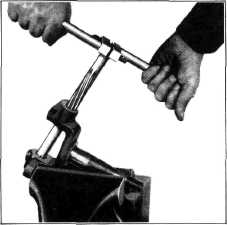1942 - 1947 CHEVROLET SHOP MANUAL
Section 3 - Front Suspension, Axle & Springs
|
|
|||
|
3-22 |
|||
|
|
|||
 |
not
available, an ordinary coarse threaded tap of the proper size can be threaded into the
bushing, and with a bar whose
diameter is slightly less than the diameter of the hole and 1 inch longer
than the distance through the
steering knuckle, drive out
the tap and bushing.
To install new bushing, round
edges with a file; place in proper position with respect to knuckle to
align oil holes, noting that the oil
hole is nearer one end than
the other. Press into place with a vise or arbor press, taking care to start
bushing straight into the hole.
Do not hammer on bushing or
otherwise deform it.
After the bushings are in place,
they should be carefully reamed to
size, using a reamer long enough to reach through both bushings at
once, or preferably a reamer having a
long pilot bar which will just
pass through the opposite bushing while one is being reamed, the cutting flutes
also being long enough to finish both bushings together. Fig.
48.
NOTE—When oversize kingpins are
installed it is necessary to ream the steering knuckle bushings first
with the reamer used for fitting a standard size kingpin, and then with
the special oversize reamer to fit the .010" or .020" oversize
kingpin, to provide .002" clearance between the kingpin and
bushing. |
||
|
Fig. 46—Reaming Steering Knuckle Bushings
REMOVE AND INSTALL
STEERING
KNUCKLE BUSHINGS,
I-1/2-TON
TRUCKS
A bushing puller should be used
in removing steering knuckle bushings.
If a tool of this kind is |
|||
|
|
|||
|
FRONT AXLE SPECIFICATIONS |
|||
|
|
|||
 |
|||
|
|
|||
|
FRONT SPRINGS |
|||
|
|
|||
|
1/2 AND 3/4-TON LONG WHEELBASE
TRUCK
The front
springs on the 1/2 and 3/4-ton long Wheelbase truck are flat under load,
contributing to improved
steering geometry by reducing to a minimum the fore and aft movement of the
front axle and attaching parts.
The rear eye of the front spring is of the "Berlin" type, meaning that the
horizontal center is
approximately level with the main leaf center.
3/4 AND 3/4-TON SPECIAL TRUCK
The front
springs of the 3/4 and 3/4-ton special truck are "two-stage" type, or in other
words the spring rate with the truck light is
considerably |
lower than
when loaded. The advantage of this type spring is that the rebound or "throw"
is much less when the truck is
light and the resistance to "bumping through" is greater when the truck
is loaded. The change in
spring rate from the low to the
higher rate takes place at or near the rated load capacity of the truck.
154-TON TRUCK
The front
spring on the 1-1/2-ton truck is a low camber spring of high load carrying
capacity. The rear eye is also of the
"Berlin" type, with a second leaf which partially wraps the main
eye for additional safety. Front
Chassis Spring specifications are shown in the following
chart: |
||
|
|
|||